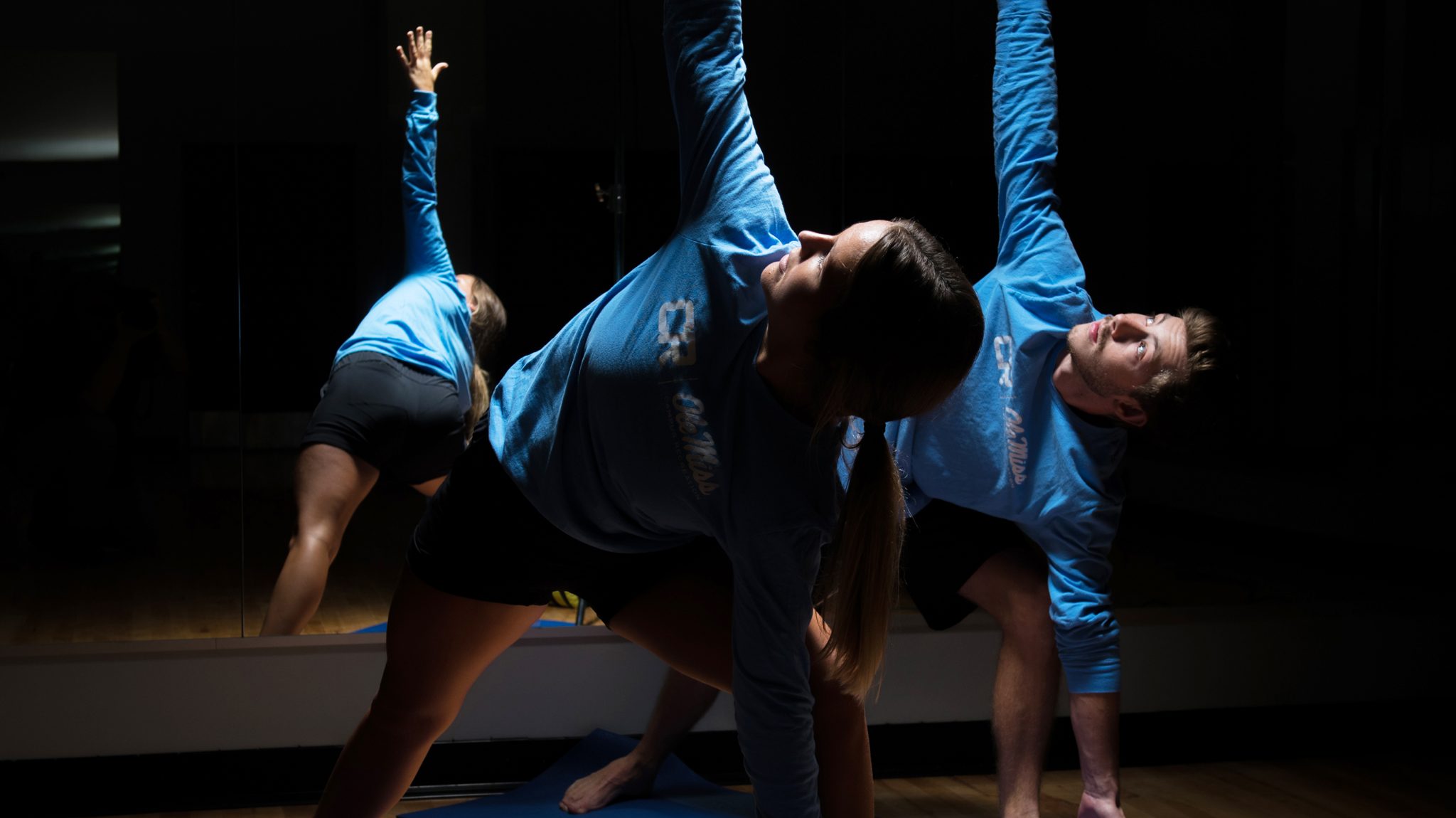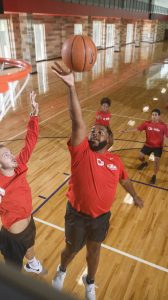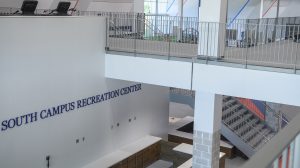
The South Campus Recreation Center at the University of Mississippi offers spaces and programs for students to explore a variety of activities, helping them to make healthy choices and connections that will benefit them throughout their lives. Photo by Thomas Graning/Ole Miss Digital Imaging Services
OXFORD – The University of Mississippi‘s new South Campus Recreation Center will provide a state-of-the-art facility where students can lift weights, rock climb and participate in a variety of health and exercise options.
But the center will also be a place where students seek wellness education, learn to make healthy decisions and find their university family, just like Ole Miss junior Bailey James did when he arrived on campus three years ago.
“Growing up, my life was always centered around my family,” said James, an exercise science major from Meridian who works at the Department of Campus Recreation. “We ate dinners every single night together and did everything together, so moving away was one of the most challenging things for me.
“But from the moment I connected with Campus Recreation at orientation, whether I’m just going to the gym to work out or going to work, there’s so many people there that have just become my family. Whenever I’m here, they really help fill that void.”
The $32 million South Campus Recreation Center will open Monday (Aug. 26). The facility is at the former Whirlpool property, off Chucky Mullins Drive south of Mississippi Highway 6. A ribbon-cutting ceremony is set for 3:30-5:30 p.m. Aug. 28.
It’s connections like the ones James has made that Peter Tulchinsky, campus recreation director, sees as being the focal point of the new recreational facility.
“It’s my hope that the new center generates an uptick in participation and the number of people that come through those doors,” Tulchinsky said. “If we can bring some new participants in and they have positive experiences and they come back with a couple friends, then you start to create a culture around physical activity and well-being.
“It can also create a more social campus and foster a stronger community environment. Rec centers are one of the few community gathering places that exist on college campuses, and I think one of the best things about our work is we are able to bring faculty, staff, students and community members all to one place.”

The South Campus Recreation Center at the University of Mississippi provides nearly 100,000 square feet of workout space, including a large functional training zone, an indoor climbing wall, 25,000 square feet of fitness space, fitness studios, basketball courts, a multiactivity court and other amenities. The facility is at the former Whirlpool property off Chucky Mullins Drive south of Mississippi Highway 6. Photo by Thomas Graning/Ole Miss Digital Imaging Services
Building community and social interaction is just one of the many hidden benefits that campus recreation provides, and Tulchinsky sees the new recreation center as an integral part of a holistic approach to educating college students.
“There’s plenty of research that shows the positive impacts physical exercise has on your brain,” he said. “It helps people that have anxiety and helps those that may be exhibiting symptoms of depression. When we look around our campus, we see a number of students that are dealing with these types of issues.
“We have an opportunity to help combat those issues through exercise. You just have to be committed and make it a part of your lifestyle. It’s accessible to everyone.”
Tulchinsky cited an initiative in Naperville, Illinois, that showed increased standardized test scores when a daily exercise program was administered to students at the beginning of the day.
“You see things like that and you realize there is this kind of magic pill: it’s exercise,” he said. “By making people aware of their opportunities and helping people get started with exercise, we can help address some of the things we’re seeing with mental health.”
But exercise is not all the facility offers. Classes on physical wellness, mental health, sexual wellness and other programs designed to educate college students on making the right decisions will be offered. The center also includes the new William Magee Center for Wellness Education, designed to educate students on alcohol and drug misuse.
Successfully completing a college career is all about managing stress levels and making healthy choices, and the variety of services the new recreation center provides will help students achieve that mission, said Bud Edwards, director of the University Counseling Center.
“I think sometimes people artificially separate physical stress on their body from mental stress, and you can’t do that,” Edwards said. “One aspect of a good stress management strategy is to keep your body as healthy as you can. There’s an exercise component to that, there’s a diet component to that and there’s a good hygiene component.”
Edwards said the recreation center fits into this strategy not only by providing opportunities for students to access services on their own, but also through a referral program where the Counseling Center connects students with issues in these areas to programs provided by Campus Recreation. The new center will increase the number of these programs the university can provide for students.
“The idea is you can get folks trained on the machines and exercises over at the rec center or get acquainted with some of the classes, but if you have somebody helping you acclimate to those things and helping you get into the routine of doing those things, then you build a habit,” Edwards said.
In turn, the effects of these programs and regular exercise can benefit student performance, Tulchinsky said.
“We’ve seen a correlation in increased GPA and recreation center utilization, which we’ve also seen from our peer institutions,” he said. “By and large, students that utilize rec centers have GPAs that are higher than students that never walked through the door.”
Sophomore psychology major Kaelyn Thompson, a Pearl native, has experienced the benefits of regular exercise firsthand.
“When I got here as a freshman, (going to the gym) was pretty much my nightly routine,” she said. “Once I finished my homework, then I would go to the gym. I work at the Turner Center, I’m a student and I’m also the president of the women’s club basketball team.
“So being a college student comes with a lot of responsibility, and it can be overwhelming at times. So just being able to go to the gym and exercise and clear my head, listen to music and just focus on that and not have to worry about all the other things that I have going on is a big help.”

The South Campus Recreation Center at the University of Mississippi includes services for wellness education, outdoor programming and personal training. Two fields for intramural sports, sport clubs and informal recreation are adjacent to the facility, and a sidewalk links the building to the South Campus Rail Trail. Photo by Thomas Graning/Ole Miss Digital Imaging Services
The South Campus Recreation Center is a 100,000-square-foot facility that features a 6,000-square-foot functional training zone, an indoor climbing wall, 25,000 square feet of fitness space, three fitness studios, two basketball courts, a multiactivity court, walking/jogging track, classroom with a demonstration kitchen and a convenience store.
Services for wellness education, outdoor programming and personal training also have dedicated spaces. Two fields for intramural sports, sport clubs and informal recreation are near the facility, and a sidewalk links the building to the South Campus Rail Trail.
Usage rates at the Turner Center hover around 37 percent of students using the facility each year, Tulchinsky said. He expects that number to jump to 50 percent with the opening of the new facility and has hopes for more.
“I think if we could get that number to 65 percent, that would be a transformative change,” he said. “And I think that’s realistic. Participants are going to have to have positive experiences when they are there, and we are going to provide programs and services that make people want to come back.”
Tulchinsky said increasing student usage is important to him because it demonstrates that the university values the total well-being of all its students, and he hopes the new facility can set an example of valuing wellness education across the state.
“I hope the center becomes a place that is looked at as one of the most important places on campus that helps students be successful during their time at the university,” he said.
Junior biology major Beth Sherbo, who works with Campus Recreation in the aquatics center, has seen firsthand the benefits of working with guests who are not Ole Miss students.
“In aquatics we have a lot of interaction with the community,” the Willow Springs, Missouri, native said. “And that’s awesome. Community members are some of my favorite patrons.
“For instance, one of the Ole Miss librarians comes in every single morning to swim laps, and we have really gotten to know each other; she always keeps up with my endeavors. We also have a lot of families that want swim lessons, so that’s a great way for us to positively impact the community.”
Students and campus officials alike have high hopes for the facility and the impact it can have on the community.
“People are drawn to new things, and this facility is going to impress our campus community,” Sherbo said. “There is going to be a “wow” factor.
“It’s going to be a showcase facility for our campus. And hopefully, it can be a transformative place for improving personal health and well-being.”